Shimoda, a picturesque town on the Izu Peninsula, is a treasure trove of stunning natural landscapes, rich history, and unique cultural experiences. From breathtaking beaches and geological wonders to vibrant marine life and charming historic streets, Shimoda offers something for every traveler. In this guide, we highlight 10 must-visit spots that showcase the best of this coastal paradise. Whether you’re seeking relaxation, adventure, or a journey through time, Shimoda is the perfect destination for your next trip.
Shimoda Floating Aquarium
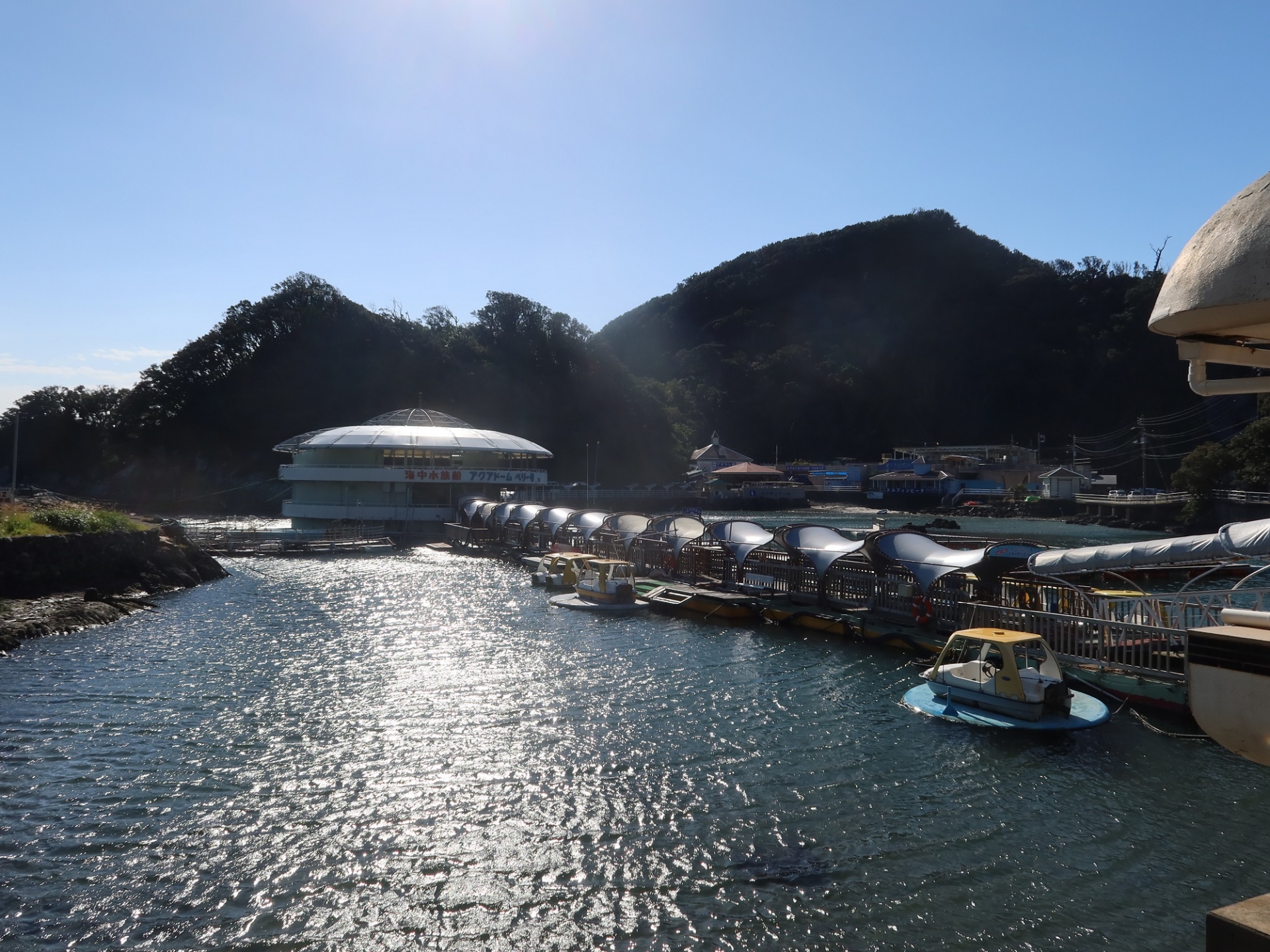
The Shimoda Floating Aquarium offers a one-of-a-kind experience. Nestled in a natural cove in Izu Shimoda, this unique floating circular aquarium lets visitors immerse themselves in marine life like never before. Here’s what makes it an unforgettable destination.
Shimoda Floating Aquarium offers more than just standard dolphin shows or feeding sessions. With seven unique programs, guests of all ages can get closer to dolphins than ever before. From feeding dolphins while giving commands for jumps and handshakes in the Dolphin Feeding program to observing dolphins up close in the Ukiuki Dolphin session, there’s something for everyone. Families can enjoy private feeding experiences through the Family Dolphin plan, or wade into shallow waters to interact with dolphins at Dolphin Beach. For the more adventurous, snorkeling and diving options, such as Dolphin Snorkeling and Dolphin Diving, allow you to swim or dive alongside these friendly creatures in their natural habitat. The Amazing Seats offer a unique perspective on dolphin shows, where guests can enjoy performances at sea level and witness the energy and expressions of the dolphins up close.
The aquarium isn’t just about dolphins. Visitors can also interact with a variety of other marine creatures. Highlights include touching and photographing sea lions in the Sea Lion Encounter, feeding seals, sea turtles, otters, and penguins, and experiencing the unique texture of a bamboo shark or relaxing with a doctor fish session. Guests can also join the Backyard Tour, which provides a behind-the-scenes look at aquarium operations and marine care.
Another must-see is the Aqua Dome Perry, a biodiverse exhibit featuring 10,000 marine creatures across 50 species, including fish, invertebrates, and seaweeds. The dome’s immersive design makes visitors feel as though they are walking through the ocean itself, experiencing the beauty of Izu’s waters firsthand.
For those curious about the daily work of aquarium staff, the “Waku Work” program offers hands-on experience. Participants can prepare food for the dolphins, observe their training sessions, and gain insight into the life of a dolphin trainer. This program is perfect for children and adults who want to learn more about marine life and conservation efforts.
Shimoda Floating Aquarium is an ideal destination for families. The variety of activities ensures that children stay engaged and have fun while learning about marine life. Whether it’s touching a sea lion, feeding a penguin, or swimming with dolphins, these experiences are bound to leave lasting memories. Parents can rest assured that their children will enjoy a day full of excitement and discovery, making it a highlight of their Izu trip.
Whether you’re traveling solo, as a couple, or with children, the Shimoda Floating Aquarium promises a day of wonder and joy. Add it to your Izu itinerary and let the beauty of marine life captivate you.
Ryugu Sea Cave
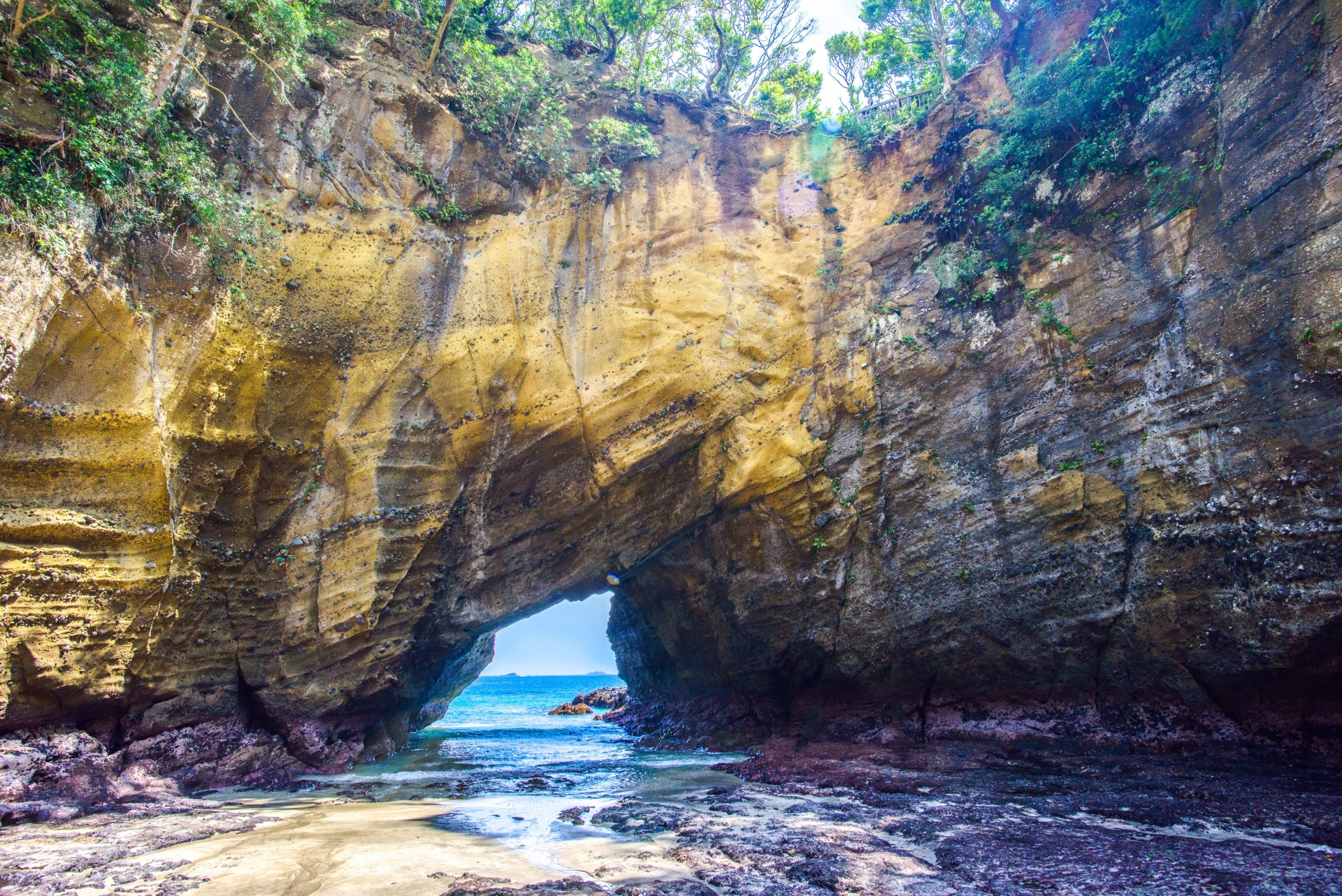
Ryugu Cave is a cavern featuring a stunning 50-meter-wide skylight at its ceiling, creating a magical atmosphere. From inside, visitors can look up to see a wide, circular opening to the sky, while a walking path above the cave allows for a scenic stroll around its rim.
The cave feels spacious and awe-inspiring, with its natural skylight offering breathtaking views of the sky. What makes Ryugu Cave particularly special is its heart-shaped landform, visible when looking down from the walking path above. This unique feature has earned it a reputation as a “Love Power Spot,” drawing couples, families, and friends eager to deepen their bonds and create memorable experiences.
The cave owes its existence to ancient volcanic activity. Southern Izu is home to layers of rock formed from underwater volcanic eruptions millions of years ago. Over time, these layers were uplifted and sculpted by waves. Weaker parts of the rock were eroded, forming the cave, and the ceiling partially collapsed, giving birth to the dramatic skylight seen today.
Ryugu Cave is a place where nature and romance come together. Its heart-shaped geography makes it a favorite destination for couples expressing gratitude for their love, as well as for friends and families strengthening their connections. Whether you’re drawn to its geological history or the charm of its romantic reputation, Ryugu Cave offers a serene and memorable outing for all.
Be sure to add this LOVE POWER SPOT to your Izu itinerary for an unforgettable experience that blends natural beauty, cultural significance, and heartfelt moments.
Shirahama Shrine|A Timeless Sanctuary by the Sea
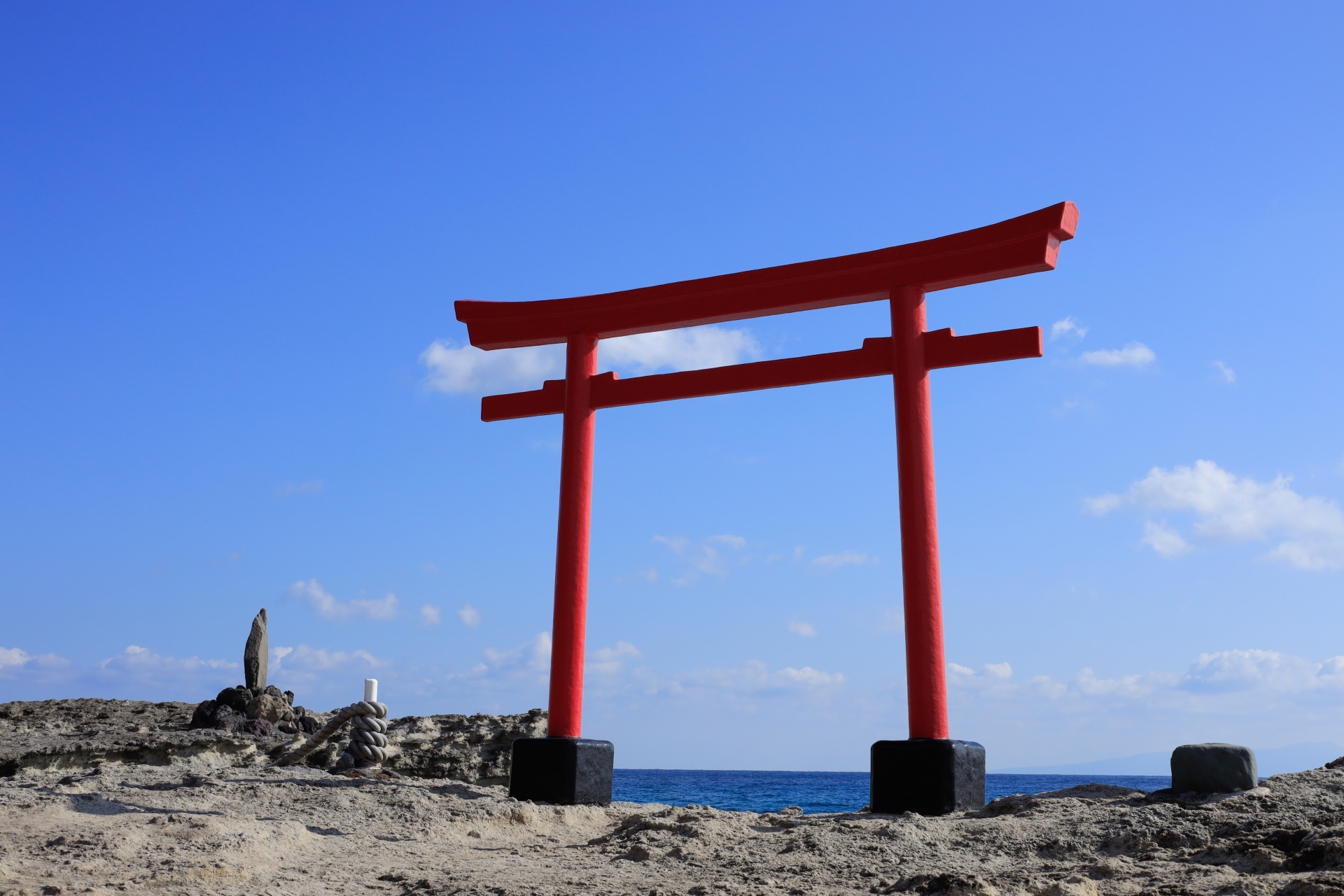
Nestled in the hills overlooking the pristine white sands of Shirahama Beach in Shimoda, Shirahama Shrine is the oldest shrine in Izu, boasting a remarkable history of 2,400 years. With its majestic main hall and iconic torii gate facing the beach, this sacred site offers visitors a serene and enchanting experience throughout the year.
Surrounded by a lush forest, the shrine is easily identifiable by its dense greenery along the coast. As you step into the grounds, you’ll be greeted by towering sacred trees, each steeped in history. Notable among these is the Yakushi no Byakushin, a 2,000-year-old juniper tree. Within its hollowed trunk lies a small shrine dedicated to Yakushi Nyorai, a deity believed to bring healing. Opposite this tree stands the Hakuryu no Byakushin, a striking, vine-covered tree with an estimated age of 1,000 years before it dried and another 1,300 years as it stands today. Together, these ancient trees echo the shrine’s profound spiritual significance and enduring legacy.
As you pass through the forest and approach the shrine, the grandeur of Shirahama Shrine unfolds. Its formal name, Ikonahime no Mikoto Shrine, honors Ikonahime no Mikoto, a goddess who, according to legend, became the consort of Mishima Daimyojin, a deity who traveled to Izu on the warm Kuroshio Current. The shrine exudes a solemn atmosphere, from its elegant worship hall to the revered main sanctuary located further within the grounds.
One of Shirahama Shrine’s highlights is its torii gate overlooking Shirahama Beach, where the forest opens to the sea. This iconic sight connects the sacred grounds to the vast ocean, creating a breathtaking blend of spirituality and natural beauty. The torii is easily accessible via a path from the shrine’s parking area, which offers one hour of free parking for visitors coming to pay their respects.
Shirahama Shrine seamlessly blends its rich history, mythological roots, and scenic location, offering visitors a spiritual retreat unlike any other. Whether you come for the historical significance, the awe-inspiring sacred trees, or the peaceful seaside views, Shirahama Shrine promises an unforgettable experience. It’s a place where the beauty of nature and the depth of Japanese tradition come together to create lasting memories.
Shirahama beach|Izu Peninsula’s Largest and Most Popular Beach
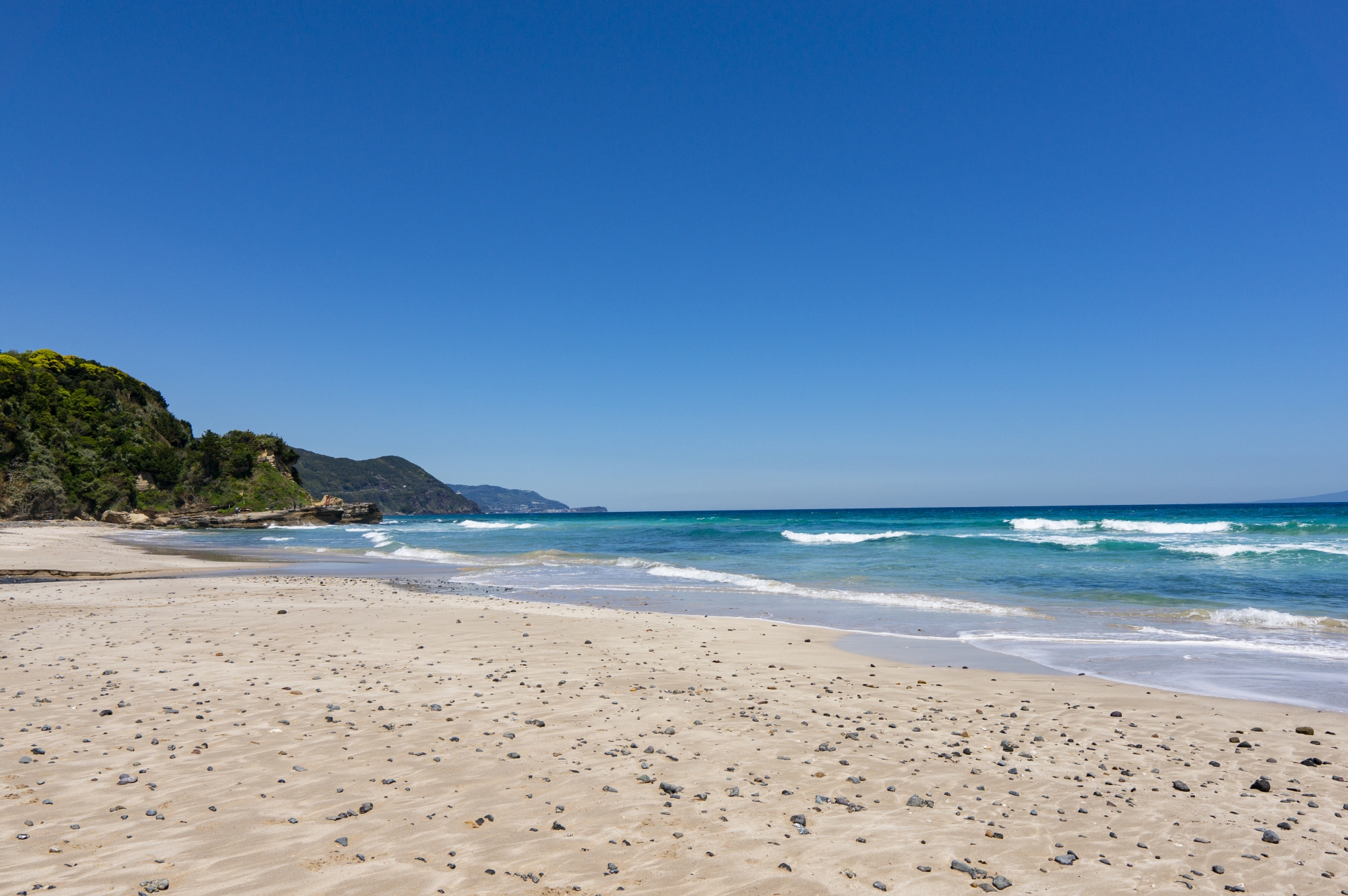
Shirahama Beach is a must-visit destination for travelers exploring the Izu Peninsula. Known as one of Japan’s most famous and picturesque beaches, it offers a stunning combination of white sandy shores and emerald-green waters, captivating visitors from across the country. Spanning an impressive 700 meters in length and 90 meters in depth, this beach is the largest and most vibrant on the peninsula, providing ample space for relaxation and activities.
The beach’s open layout, with its sandy shores adjacent to the coastal road, creates a sense of freedom and accessibility. During the summer months, Shirahama Beach comes alive with surfers, young travelers, and families enjoying the vibrant atmosphere. Even outside the peak season, its fine white sands and expansive views make it a peaceful retreat, perfect for a quiet stroll or a moment of reflection by the sea.
Shirahama Beach is well-equipped with facilities to ensure a comfortable and enjoyable visit. Visitors can take advantage of 300 parking spaces, public restrooms, and showers available for ¥300. Rental services include umbrellas, beach beds, bodyboards, and float rings. Changing rooms are conveniently combined with shower facilities, and nearby privately operated shops and snack stands offer refreshments and beach essentials.
The beach’s official swimming season runs from July 13 to August 31, 2024, with operating hours from 8:00 AM to 4:00 PM, but its beauty can be appreciated year-round. Shirahama Beach also features designated areas for surfing, making it a favorite spot for wave enthusiasts.
Whether you’re visiting to soak up the summer sun, enjoy water activities, or simply marvel at the breathtaking views, Shirahama Beach is a destination that guarantees unforgettable memories. Its pristine sands, crystal-clear waters, and welcoming facilities make it an ideal seaside escape on the Izu Peninsula.
Shimoda Ropeway
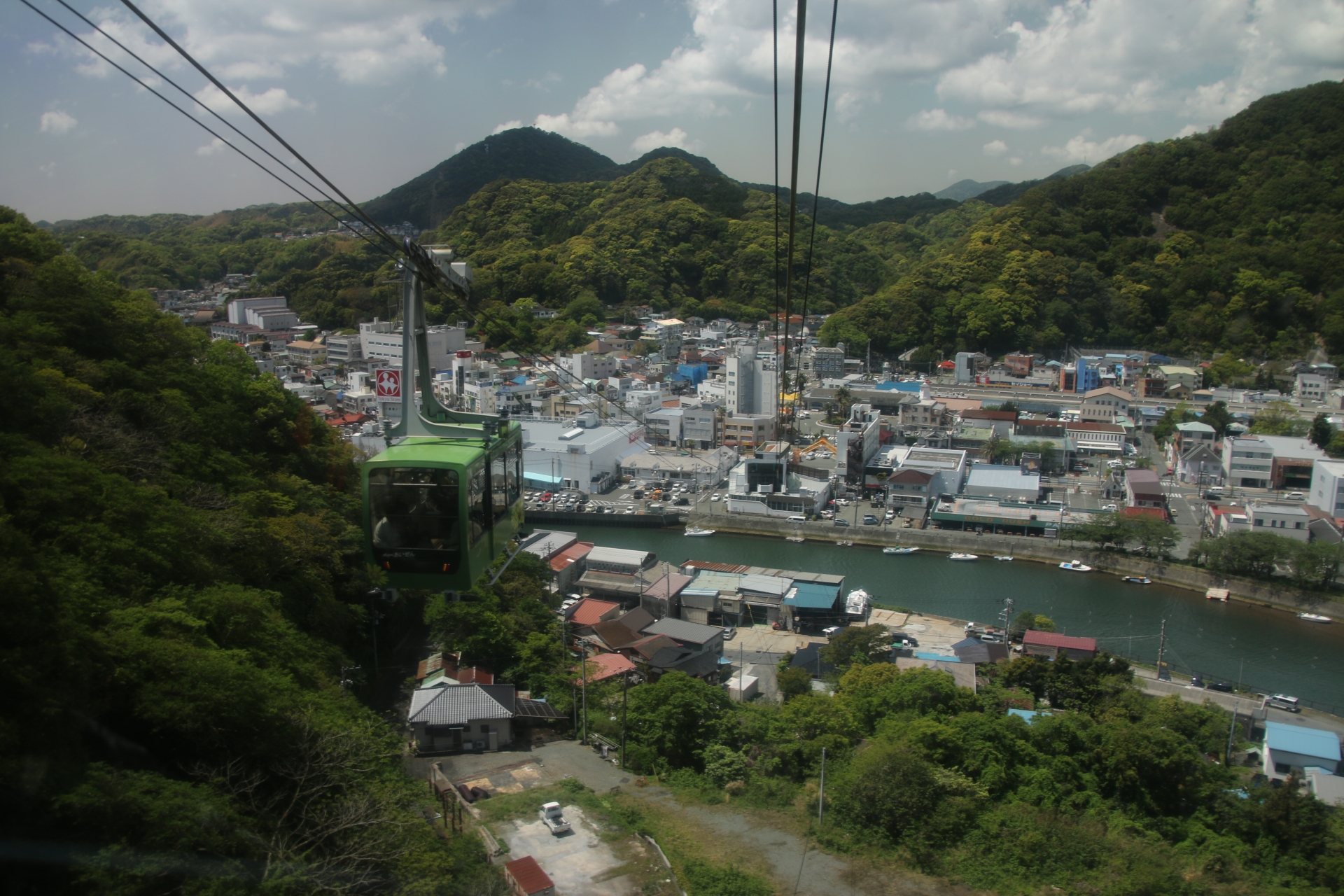
The Shimoda Ropeway, located just outside Izukyu-Shimoda Station, offers a quick three-minute ride to the summit of Mount Nesugata, renowned for its resemblance to a reclining woman.
The royal-blue gondolas, redesigned in 2019 by famed designer Eiji Mitooka, feature elegant interiors with traditional yosegi woodwork flooring. From the summit, visitors are treated to breathtaking views of Shimoda Port—a historical site linked to Japan’s opening to the West during the Edo period—and, on clear days, the Izu Islands.
The summit also features The Royal House, a restaurant with terrace seating and stunning vistas, where guests can enjoy its signature katsu curry, a dish supervised by a renowned Tokyo chef. Adding to its charm, the summit is home to Aizen Myo-o Hall, a well-known power spot for love and relationships, where visitors can write their wishes on heart-shaped ema plaques.
For history enthusiasts, the reconstructed Bakumatsu Lookout Hut offers a glimpse into the Edo period, when officials kept watch for foreign ships. Combining history, culture, scenic beauty, and culinary delights, the Shimoda Ropeway is a must-visit destination on the Izu Peninsula.
Perry Road
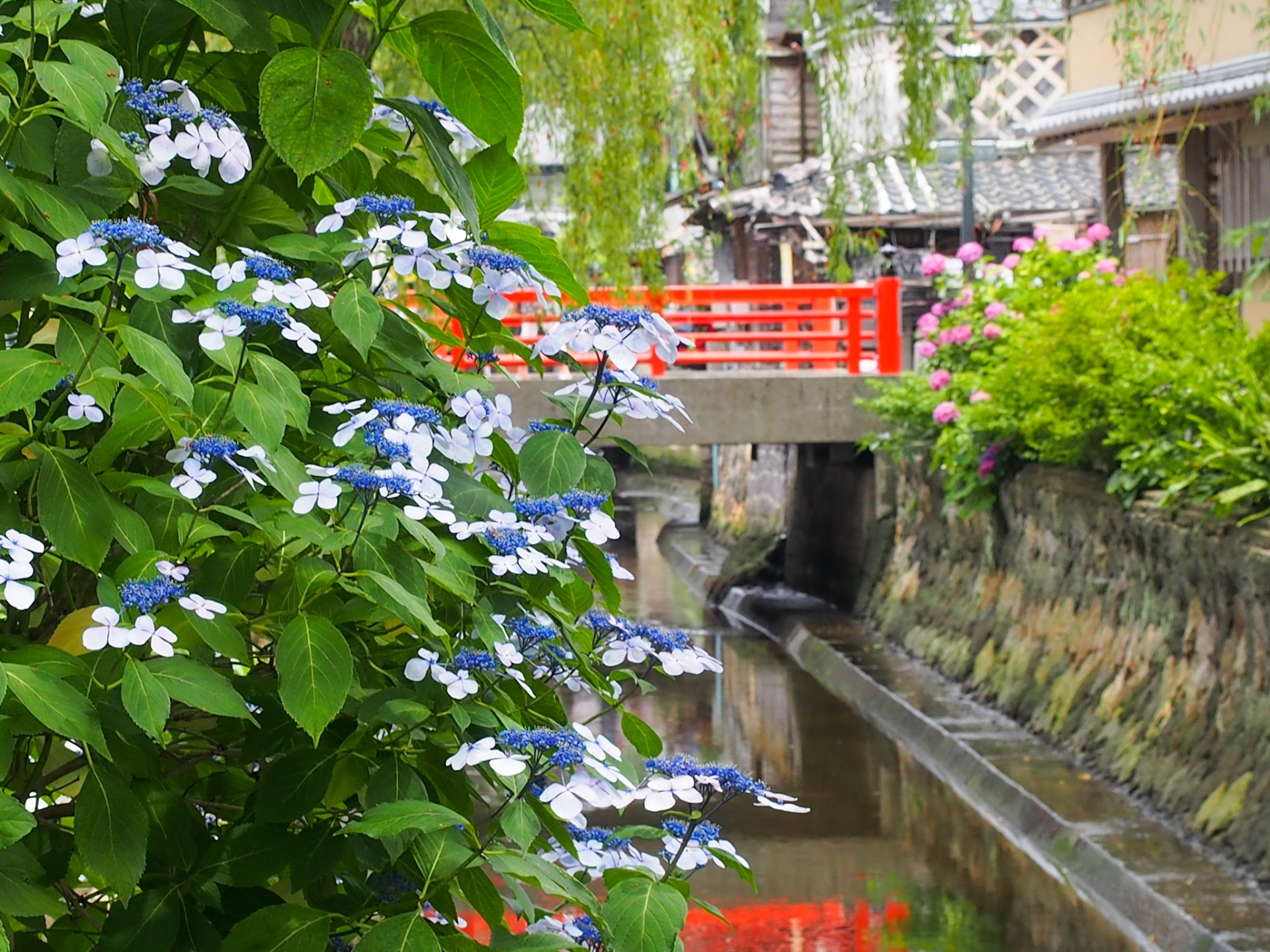
Perry Road, located in the heart of Shimoda, is a picturesque and historic pathway that offers visitors a glimpse into Japan’s late Edo period. This stone-paved road, stretching about 500 meters along the Hiraname River, is where Commodore Matthew Perry and his fleet made their processions to Ryosenji Temple to negotiate the Japan-U.S. Treaty of Amity and Commerce. Today, it is one of Shimoda’s most iconic attractions, blending history, culture, and natural beauty.
Perry Road is lined with unique features such as namako-kabe walls and Izu stone structures, which are characteristic of the buildings from the late Edo to Taisho periods. The namako-kabe walls, named for their resemblance to sea cucumbers, are a traditional plastering style where flat tiles are set into walls with raised mortar joints. Similarly, Izu stone, sourced locally from the peninsula, is soft, fire-resistant, and easy to shape, making it a staple of the area’s historical architecture.
As you walk along Perry Road, you’ll find charming willow trees lining the riverbank, stone bridges, and vintage gas lamps, all of which create a unique and nostalgic ambiance. In the evening, the gas lamps illuminate the path, transforming the area into a dreamlike scene perfect for a romantic stroll.
The road is steeped in historical significance, as it was a key route for Commodore Perry’s entourage during the negotiations that opened Japan to the West. Visitors can also explore nearby landmarks such as Ryosenji Temple, where the Japan-U.S. treaty was finalized, and Chorakuji Temple, the site of the Japan-Russia Treaty of Amity. Shimoda Park, famous for its hydrangea festival, is also within walking distance, making Perry Road a gateway to Shimoda’s rich cultural heritage.
In addition to its historical allure, Perry Road is home to a variety of unique shops, cafes, and restaurants that harmonize with the area’s traditional aesthetic. The combination of old-world charm and contemporary offerings makes it a delightful destination for all travelers.
Whether you visit during the day to admire the traditional architecture or in the evening to enjoy the romantic glow of the gas lamps, Perry Road offers a memorable journey through one of Japan’s most significant historical locations.
Cape Tsumeki
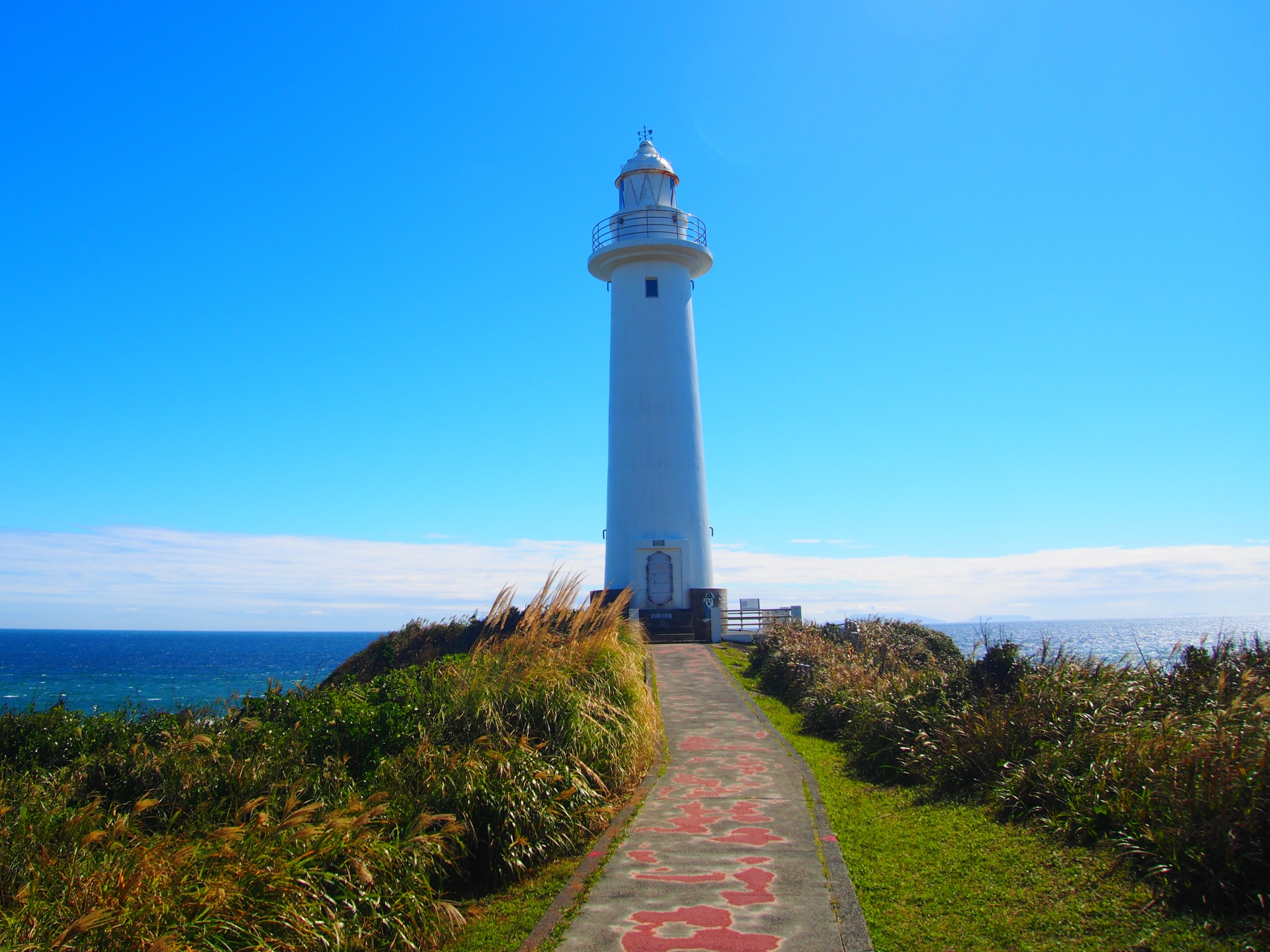
Cape Tsumeki, located at the southeastern tip of the Susaki Peninsula, is one of Japan’s most beautiful scenic spots. Renowned for its breathtaking coastal views, the cape features a white lighthouse, dramatic columnar cliffs known as “Tawara Iso,” and a stunning flower garden that showcases blooms year-round. The combination of clear blue seas and lush green hills makes this destination a haven for nature lovers and photographers alike.
The cape is celebrated for its crystal-clear waters and striking natural contrasts. On sunny days, the vibrant blue of the ocean meets the fresh greenery of the surrounding hills, creating a mesmerizing display of color. A highlight is the columnar jointed cliffs, a natural geological formation with hexagonal rock columns. Locally called “Tawara Iso,” these cliffs are designated a Shizuoka Prefectural Cultural Property, adding historical significance to the area’s natural beauty.
From December 20 to January 31, Cape Tsumeki comes alive with its famous Daffodil Festival, where an astounding three million daffodils bloom, filling the area with their sweet fragrance. The festival also features local products and food booths, making it a lively event for visitors. It’s a unique chance to experience the beauty of winter in a vibrant and aromatic setting.
Within the cape’s grounds lies a flower garden, where seasonal blossoms provide a colorful display year-round. Adjacent to the garden, a subtropical greenhouse showcases exotic plants such as papayas, bougainvillea, and bananas, offering visitors a glimpse of tropical beauty.
A well-maintained 2.8 km walking path connects Susaki Fishing Port and Cape Tsumeki, offering scenic views of the Pacific Ocean and nearby Izu Islands, including Niijima and Toshima. The trail allows visitors to enjoy the refreshing ocean breeze while marveling at the vast seascape, making it an excellent choice for a leisurely stroll or a nature walk.
Cape Tsumeki is easily accessible, just a 22-minute bus ride from Izukyu-Shimoda Station, followed by a short walk. Whether you’re exploring the vibrant daffodil fields, walking along the dramatic cliffs, or enjoying the subtropical plants, Cape Tsumeki offers a perfect blend of natural beauty and cultural charm.
Tatadohama beach
Tatadohama Beach, located in Shimoda City, is a beautiful 450-meter stretch of white sand known for its crystal-clear waters and vibrant surfing scene, making it a popular destination for visitors of all ages. From beginner bodyboarders to seasoned surfers, this beach caters to everyone, hosting national surfing competitions and offering nearby surf shops with lessons and rentals. Equipped with modern facilities, including restrooms, hot-water showers , changing rooms, and rental services for parasols, beach beds, and bodyboards, Tatadohama ensures a comfortable and enjoyable experience. Open for swimming from July 13 to August 25, 2024 (8:00 AM to 4:00 PM), the beach also features a dedicated surfing area, attracting water sports enthusiasts year-round. Easily accessible with a 7-minute bus ride from Izukyu-Shimoda Station and parking for 110 vehicles, Tatadohama Beach offers a perfect mix of relaxation and adventure, making it a must-visit spot for anyone exploring Shimoda’s stunning coastline.
Ryosenji|A Historic Landmark
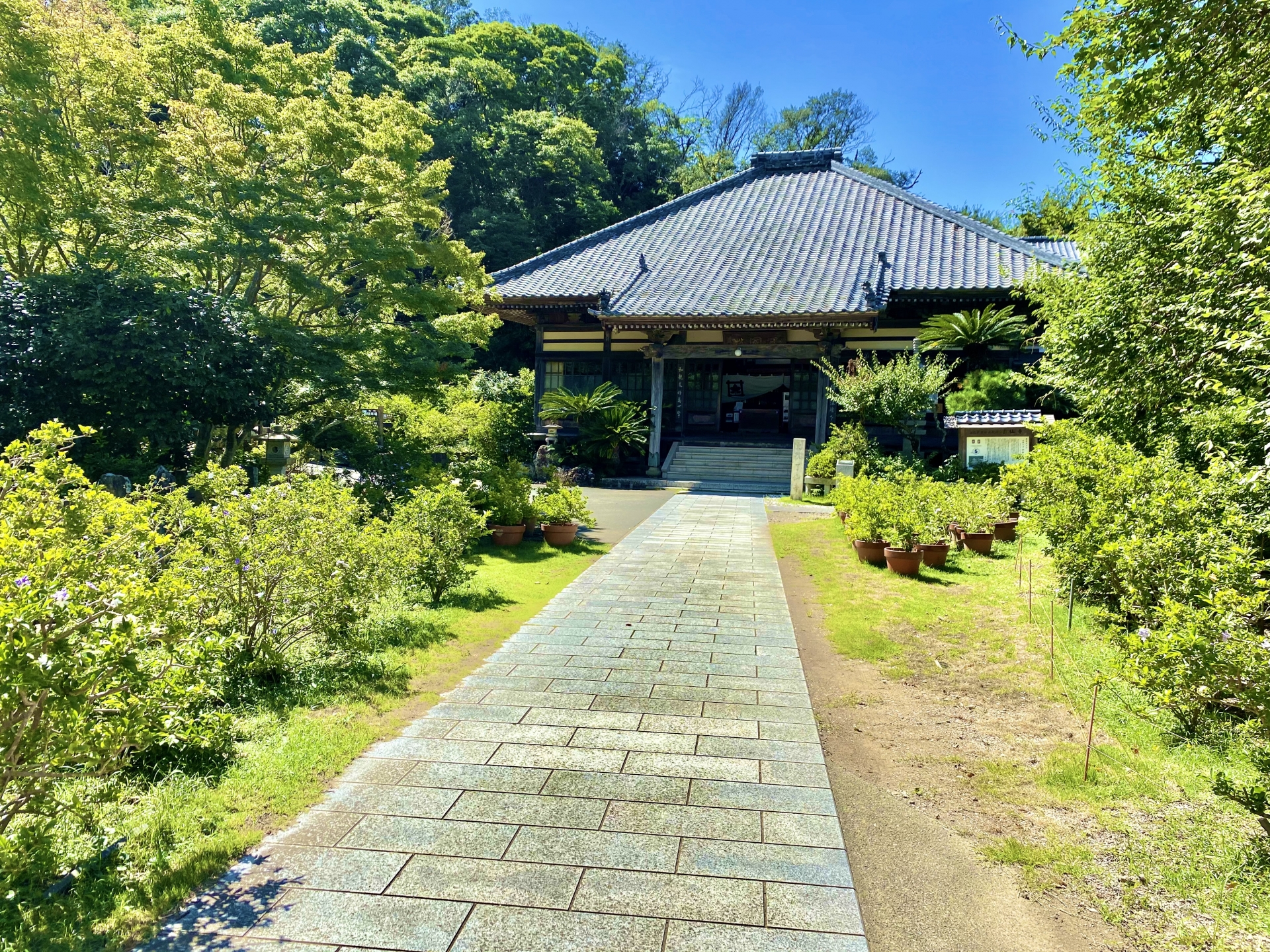
Ryosenji Temple, located in Shimoda, is a must-visit destination for history enthusiasts and nature lovers alike. Founded in 1635 during the Edo period, this Nichiren Buddhist temple played a pivotal role in Japan’s transition from isolation to international relations. It is designated as a National Historic Site, commemorating its significant place in Japanese history.
In 1854, Ryosenji became the stage for the signing of the Treaty of Shimoda, a supplementary agreement to the Treaty of Peace and Amity between the United States and Japan. This marked the end of Japan’s centuries-long policy of isolation, with Shimoda becoming the first port opened to foreign ships. Visitors can walk the very grounds where Commodore Perry and Japanese officials negotiated this historic agreement, making Ryosenji a cornerstone of cultural exchange in Japan.
Within the temple grounds lies the MoBS Black Ship Museum, home to Japan’s largest collection of artifacts related to Perry’s expedition and the Black Ships. Over 3,000 original items, including documents, paintings, and cultural relics, provide an unparalleled glimpse into this transformative period of Japanese history. Many of the iconic images of Perry and the Black Ships seen in textbooks and media originate from this museum’s extensive collection.
Ryosenji is also celebrated for its natural beauty. Known as the “Temple of Jasmine,” the grounds feature hundreds of American Jasmine (Cestrum nocturnum), locally called nioibansatsuma. These vibrant flowers bloom in mid-to-late May, filling the air with their sweet fragrance. During this time, the temple hosts the “Fragrant Flower Festival,” an event that delights visitors with its enchanting atmosphere.
Ryosenji Temple is more than just a historical site; it’s a place where the past and present blend harmoniously. Whether you’re exploring the museum’s rich collection, walking the paths once graced by Perry’s procession, or basking in the floral beauty of jasmine blossoms, Ryosenji offers an experience that is both educational and serene. Don’t miss this opportunity to step into one of the most significant chapters of Japan’s history while enjoying the tranquility of its lush surroundings.
Road Station Kaikoku Shimoda Minato

Located right in front of Shimoda Port, Road Station Kaikoku Shimoda Minato is a must-visit spot for travelers exploring Shimoda. This unique facility is home to Japan’s only Marlin Museum, where visitors can learn about the city’s maritime history and the allure of the annual International Marlin Fishing Tournament held in Shimoda. The station’s proximity to a nearby fish market and shops offering an array of local seafood and produce ensures a delightful experience for food lovers.
The roadside station is easily accessible from National Route 135, with a spacious multi-level parking lot making it convenient for visitors arriving by car. As the gateway to Shimoda from the east, this facility serves as an excellent starting point for your journey. Inside, you’ll find a tourist information center, souvenir shops, and restaurants, as well as the Marlin Museum, which showcases Shimoda’s fishing heritage.
Shopping is a highlight at Kaikoku Shimoda Minato, with four large stores offering fresh seafood, processed goods, and locally sourced fruits and vegetables. The JA Direct Sales Center features produce from local farmers, including pickles, citrus honey, and other unique products. Don’t miss the honey made from mandarin orange blossoms and New Summer Orange flowers, which pairs perfectly with yogurt or ice cream for a refreshing treat.
For a taste of Shimoda’s culinary treasures, head to Ra-maru Cafe & Burger on the first floor. The cafe serves the iconic Kinmedai Burger (alfonsino fish burger), a local specialty that’s sure to satisfy your appetite. With its combination of history, gourmet food, and convenient amenities, Kaikoku Shimoda Minato is not just a roadside stop—it’s a hub of cultural and culinary exploration, making it an ideal base for your Shimoda adventure.
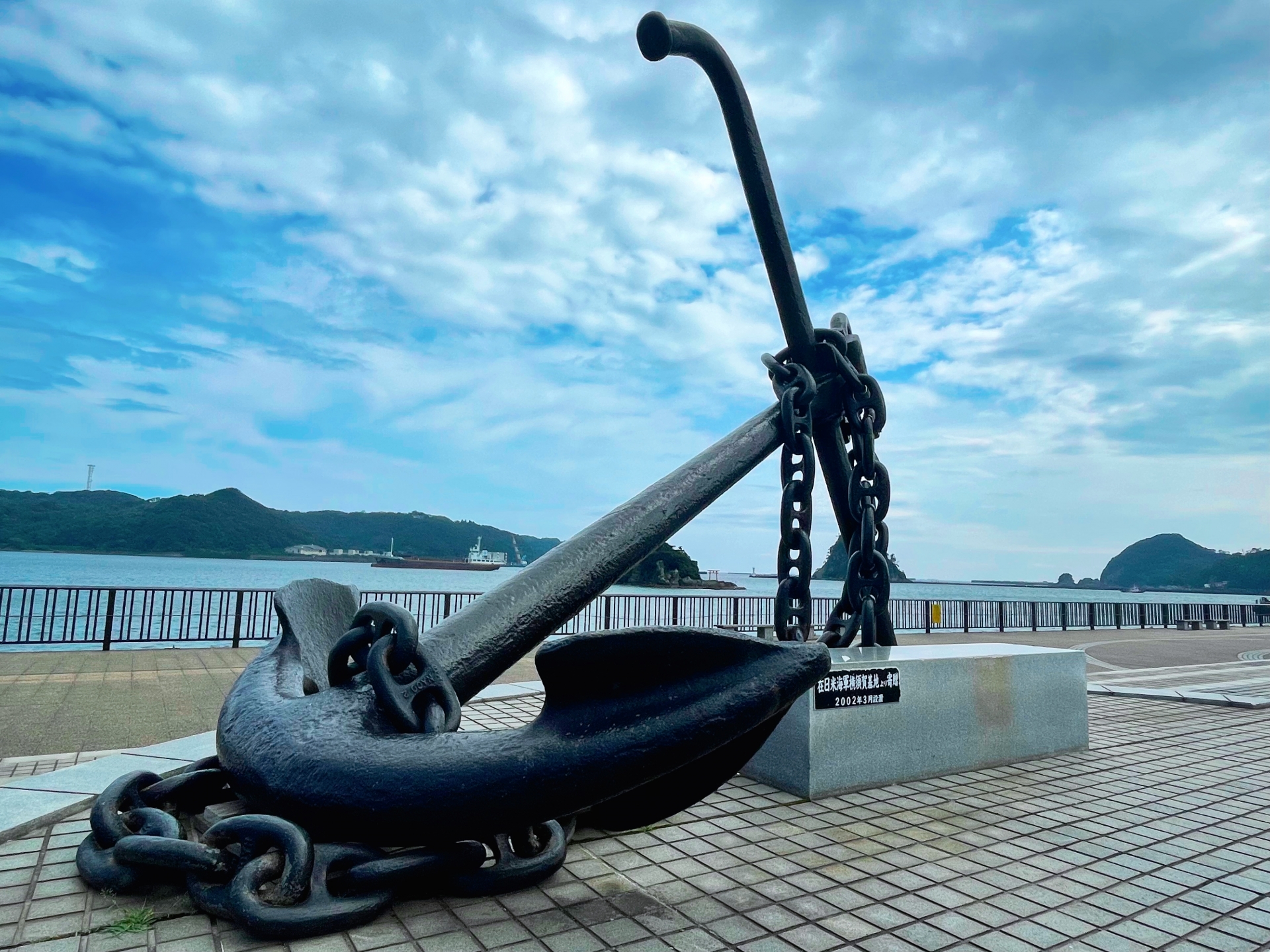
Shimoda offers a diverse range of attractions that blend natural beauty, historical significance, and vibrant local culture, making it a must-visit destination on the Izu Peninsula. From interacting with marine life at the Shimoda Floating Aquarium to marveling at the geological wonder of Ryugu Cave, enjoying the pristine sands of Shirahama Beach, or strolling through the romantic Perry Road, each location tells its own unique story. Whether you’re a history buff, a nature enthusiast, or simply looking for relaxation and adventure, Shimoda promises an unforgettable journey. Add these top spots to your itinerary and experience the charm of this coastal gem for yourself!



